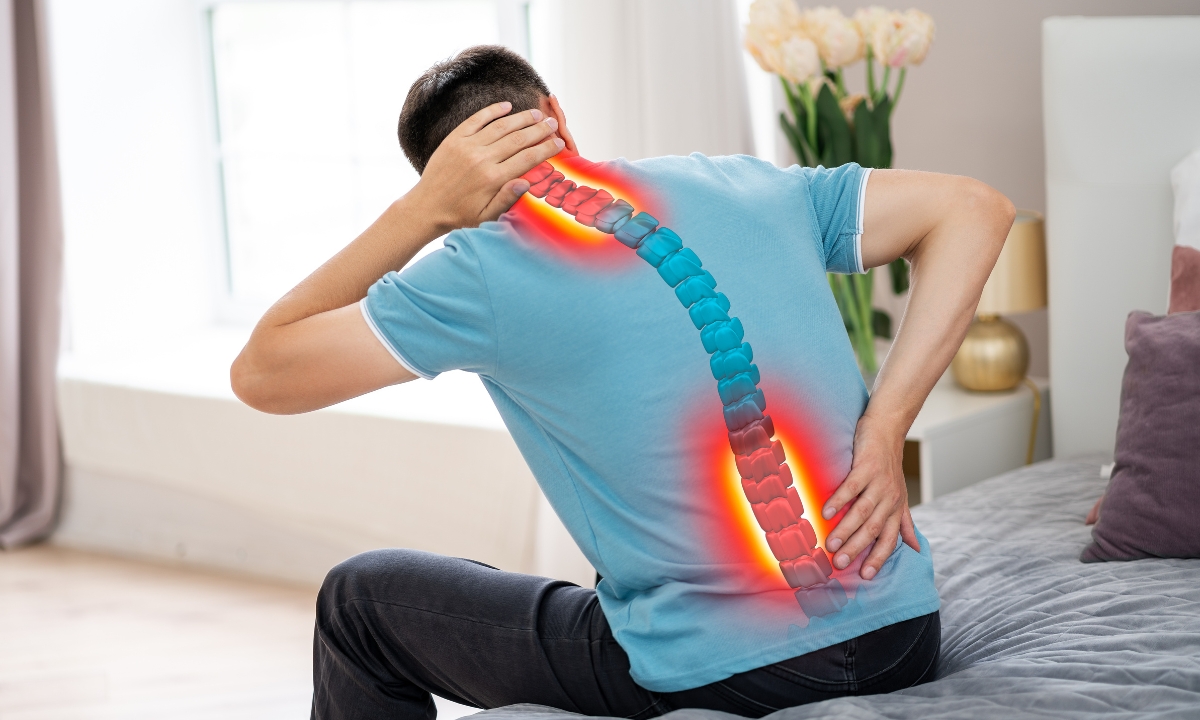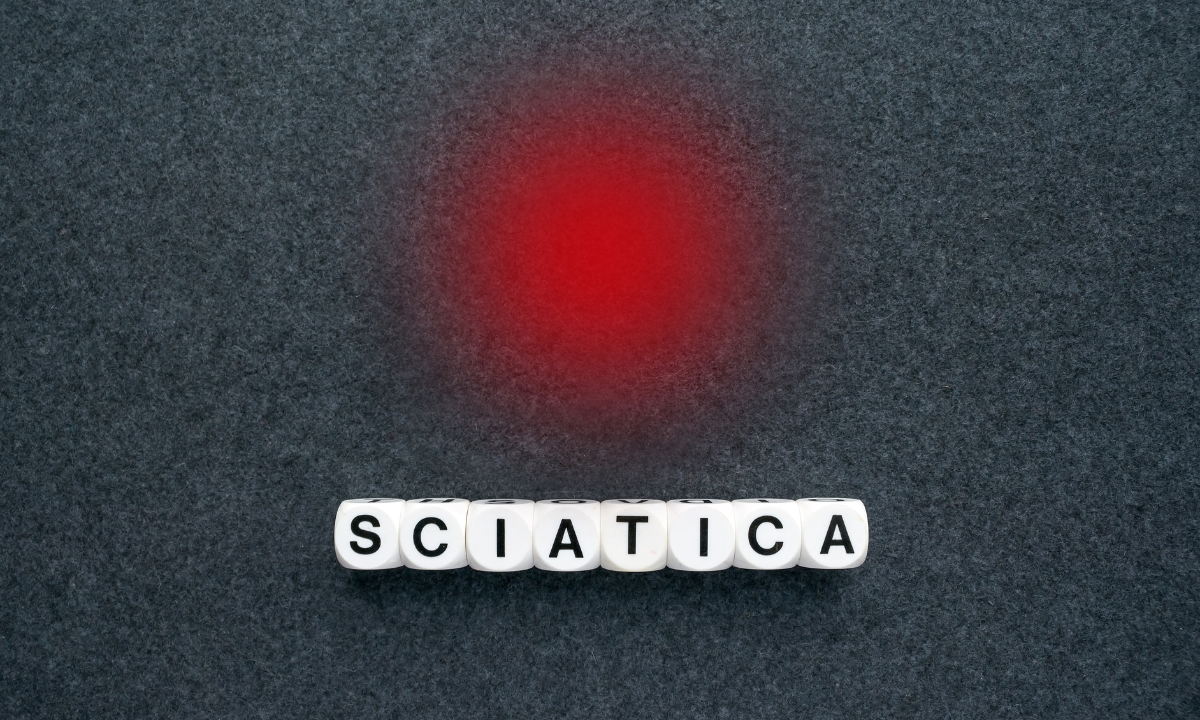“What if I told you, it doesn’t matter what side your back pain is on?” – Anonymous
Unfortunately, sciatica is quite common. In fact, come estimates suggest that around 40 percent of people will experience sciatica at some point in their lives. And while it’s more prevalent in people over 40, it can occur at any age.
Sciatica is a condition that affects millions of people worldwide, causing pain, discomfort, and sometimes significant disruption to daily life. The term sciatica is used to describe pain that radiates along the sciatic nerve, which runs from your lower back through your hips and down each leg. If you’ve ever experienced sharp, shooting pain radiating from your lower back, down through your leg, you may be familiar with this all-too-common condition.
But what exactly is sciatica, what causes it, and most importantly, how can you manage and find relief from the pain? In this article, we’ll explore the ins and outs of sciatica, offering valuable tips on how to manage the condition and improve your quality of life.
It can be a debilitating condition that significantly impacts daily life. While often uncomfortable and, in severe cases, extremely painful, sciatica is usually treatable. Also, in most cases it improves on its own over time. It can be beneficial to learn about the causes, symptoms, and treatment options for sciatica.
What is Sciatica?
Sciatica refers to pain that radiates along the path of the sciatic nerve, which runs from your lower back, through your hips and buttocks, and down each leg. This pain typically affects only one side of the body and can range from mild discomfort to severe, debilitating pain. The sciatic nerve is the largest nerve in the body. When something compresses or irritates this nerve, it can lead to sciatica.
Sciatica is not a condition in itself but a symptom of an underlying problem. The most common cause is a herniated disc, bone spur, or spinal stenosis that compresses the sciatic nerve. When the nerve is compressed or irritated, it results in inflammation, pain, and often numbness or tingling along the affected leg.
Common Symptoms of Sciatica
The hallmark of sciatica is pain that radiates from your lower back down through your buttock and into your leg. However, sciatica can present in various ways, including:
- Sharp or Shooting Pain: This is often described as a burning or stabbing sensation, which can make standing or sitting for long periods difficult.
- Numbness or Tingling: You might experience a “pins and needles” feeling in the affected leg or foot.
- Weakness: The affected leg may feel weak or fatigued, making it difficult to walk or perform regular activities.
- Difficulty moving: Sciatica can make it challenging to stand, walk, or sit for extended periods.
- Worsening Pain When Sitting: Prolonged sitting, especially with poor posture, can aggravate sciatica pain.
While the symptoms can be uncomfortable and disruptive, the good news is that many cases of sciatica can be managed effectively with conservative treatment.

Causes and Risk Factors of Sciatica
Several factors can contribute to sciatica, but the most common include:
- Herniated or Bulging Disc: When one of the discs in your spine protrudes or ruptures, it can press on the sciatic nerve, causing pain and inflammation.
- Spinal Stenosis: This narrowing of the spinal canal can put pressure on the nerves, including the sciatic nerve, leading to sciatica.
- Spondylolisthesis: The condition known as spondylolisthesis occurs when one of your vertebrae slips out of place, potentially irritating the nerve.
- Piriformis Syndrome: The piriformis muscle, located in the buttocks, can sometimes spasm or tighten, irritating the sciatic nerve beneath it.
- Degenerative Disc Disease: As we age, the discs between our vertebrae naturally wear down, potentially leading to sciatica if they lose height or develop small tears.
- Trauma or Injury: Accidents, falls, or sports injuries that affect the lower back can trigger sciatica by damaging the spine or irritating the nerve.
Risk factors for sciatica include age, obesity, prolonged sitting, and occupations or activities that involve heavy lifting or twisting motions.
Managing and Finding Relief from Sciatica
According to the Cleveland Clinic,
“Milder cases of sciatica generally go away on their own with time and self-treatment. Most people (between 80% to 90%) with sciatica get better without surgery.”
If your sciatica pain doesn’t improve after a few weeks of self-treatment, or you have concerns that you aren’t recovering as quickly as hoped, you should talk to a healthcare provider.
For many people, sciatica can improve with time and conservative treatment. Here are some effective strategies to manage and relieve sciatica pain:
- Physical Therapy and Exercise: One of the most effective ways to treat sciatica is through targeted physical therapy. A physical therapist can develop a customized program designed to stretch and strengthen the muscles that support the lower back and relieve pressure on the sciatic nerve. Core strengthening exercises, hip stretches, and hamstring stretches are often recommended.
- Maintain Good Posture: Poor posture can exacerbate sciatica symptoms. Be mindful of your posture when sitting, standing, or lifting objects. When sitting, use a chair with proper lumbar support, and avoid crossing your legs, which can strain the lower back.
- Heat and Cold Therapy: Applying a cold pack to the lower back can help reduce inflammation and numb the pain. Heat therapy, such as using a heating pad or taking a warm bath, can help relax tight muscles and improve blood circulation.
- Medication: Over-the-counter pain relievers such as ibuprofen or acetaminophen can help manage mild sciatica pain. For more severe cases, your healthcare provider may prescribe muscle relaxants or anti-inflammatory medications.
- Chiropractic Care: Chiropractic adjustments can help realign the spine, relieving pressure on the sciatic nerve. Many patients find relief through spinal manipulation and other non-invasive techniques offered by chiropractors.
- Massage Therapy: Deep tissue massage or trigger point therapy can target the muscles that may be contributing to sciatica. A skilled massage therapist can help release tension and improve circulation in the affected area, reducing pain and stiffness.
- Mind-Body Techniques: Practices such as yoga, mindfulness, and gentle stretching can help reduce stress and promote relaxation, which is important for managing chronic pain. Yoga poses that focus on stretching the hamstrings, hips, and lower back can be particularly beneficial.
- Lifestyle Modifications: Maintaining a healthy weight, staying active, and avoiding prolonged sitting can all contribute to better spinal health and reduce the risk of sciatica flare-ups. If your job requires sitting for long periods, take frequent breaks to stand, stretch, and move around.
- Important Note: This article provides general information and should not replace professional medical advice. If you’re experiencing sciatica, consult with a healthcare provider for an accurate diagnosis and appropriate treatment plan.
By understanding the causes and symptoms of sciatica and implementing appropriate self-care measures, you can effectively manage this condition and improve your quality of life.
Preventing Sciatica
While there’s no guaranteed way to prevent sciatica, maintaining a healthy weight, practicing good posture, and engaging in regular exercise can help reduce your risk. Strengthening your core muscles is particularly important for spinal support.
In fact, according to an article from Harvard Medical School,
“It might not seem obvious that a stronger core could improve your spinal health. But your core is not just your abdominal muscles, even though they are key contributors to the stability of your spine. Muscles in the back, sides, pelvis, and buttocks also are part of your core. Strengthening all of these muscles helps to support your spine.
Many types of exercise, including yoga and Pilates, can strengthen the core muscles. For example, planks and bridges are movements that target the core.”
When to Seek Professional Help
While many cases of sciatica improve with self-care, it’s important to seek medical attention if:
- The pain persists for more than a few weeks or worsens despite treatment.
- You experience severe pain, numbness, or weakness in the leg that affects your ability to walk.
- You lose control of your bladder or bowels, which could indicate a more serious condition requiring immediate attention.
Important Note: This article provides general information and should not replace professional medical advice. If you’re experiencing sciatica, consult with a healthcare provider for an accurate diagnosis and appropriate treatment plan.
By understanding the causes and symptoms of sciatica and implementing appropriate self-care measures, you can effectively manage this condition and improve your quality of life.
Taking a Positive Approach to Sciatica
Sciatica can be a painful and frustrating condition, but with the right approach to management, it’s possible to find relief and regain control over your life. By understanding the causes and symptoms of sciatica, taking proactive steps to manage the condition, and seeking professional help when needed, you can reduce pain, improve mobility, and prevent future flare-ups.
Whether through physical therapy, lifestyle adjustments, or alternative therapies, there are numerous ways to address sciatica and get back to enjoying the activities you love.

Take Control of Your Sciatica with Pain and Performance Solutions
Don’t let sciatica control your life. If you’re tired of dealing with the constant discomfort and limitations that come with this condition, it’s time to take back control. Discover how treatment options like Active Release Technique® or ART® can put you on your journey towards relief.
At Pain and Performance Solutions, we specialize in utilizing ART® treatments for sciatica pain. Our team of experts is dedicated to helping individuals like you find long-lasting relief from their symptoms. With our individualized approach and focus on addressing the underlying causes of your pain, we can help you get back to living a full and active life.
To get back to your regular life, turn to an ART practitioner for sciatica pain relief. Contact Pain and Performance Solutions today. We can set up a consultation and describe the benefits one can expect from ART.

